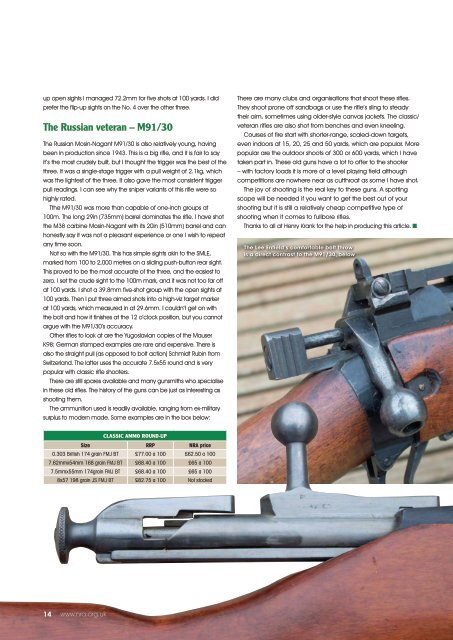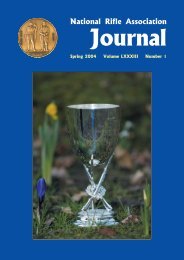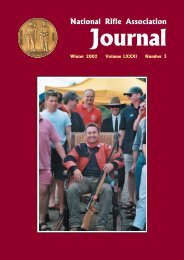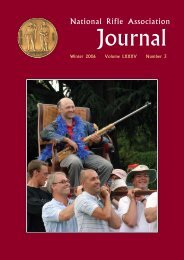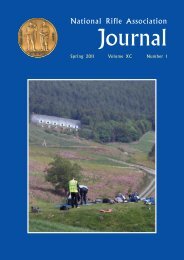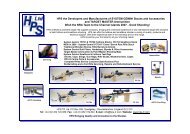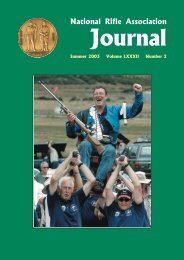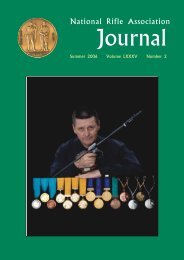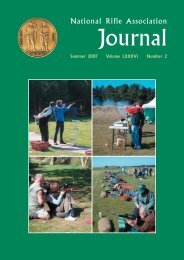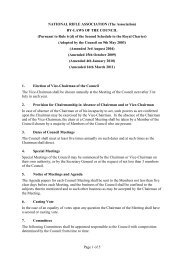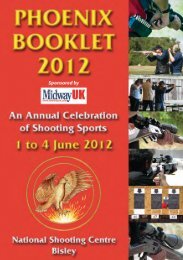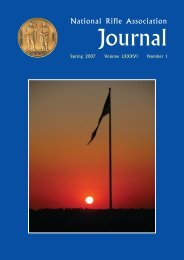Summer 2013 - National Rifle Association
Summer 2013 - National Rifle Association
Summer 2013 - National Rifle Association
- No tags were found...
You also want an ePaper? Increase the reach of your titles
YUMPU automatically turns print PDFs into web optimized ePapers that Google loves.
up open sights I managed 72.2mm for five shots at 100 yards. I didprefer the flip-up sights on the No. 4 over the other three.The Russian veteran – M91/30The Russian Mosin-Nagant M91/30 is also relatively young, havingbeen in production since 1943. This is a big rifle, and it is fair to sayit’s the most crudely built, but I thought the trigger was the best of thethree. It was a single-stage trigger with a pull weight of 2.1kg, whichwas the lightest of the three. It also gave the most consistent triggerpull readings. I can see why the sniper variants of this rifle were sohighly rated.Tthe M91/30 was more than capable of one-inch groups at100m. The long 29in (735mm) barrel dominates the rifle. I have shotthe M38 carbine Mosin-Nagant with its 20in (510mm) barrel and canhonestly say it was not a pleasant experience or one I wish to repeatany time soon.Not so with the M91/30. This has simple sights akin to the SMLE,marked from 100 to 2,000 metres on a sliding push-button rear sight.This proved to be the most accurate of the three, and the easiest tozero. I set the crude sight to the 100m mark, and it was not too far offat 100 yards. I shot a 39.8mm five-shot group with the open sights at100 yards. Then I put three aimed shots into a high-viz target markerat 100 yards, which measured in at 29.6mm. I couldn’t get on withthe bolt and how it finishes at the 12 o’clock position, but you cannotargue with the M91/30’s accuracy.Other rifles to look at are the Yugoslavian copies of the MauserK98; German stamped examples are rare and expensive. There isalso the straight pull (as opposed to bolt action) Schmidt Rubin fromSwitzerland. The latter uses the accurate 7.5x55 round and is verypopular with classic rifle shooters.There are still spares available and many gunsmiths who specialisein these old rifles. The history of the guns can be just as interesting asshooting them.The ammunition used is readily available, ranging from ex-militarysurplus to modern made. Some examples are in the box below:There are many clubs and organisations that shoot these rifles.They shoot prone off sandbags or use the rifle’s sling to steadytheir aim, sometimes using older-style canvas jackets. The classic/veteran rifles are also shot from benches and even kneeling.Courses of fire start with shorter-range, scaled-down targets,even indoors at 15, 20, 25 and 50 yards, which are popular. Morepopular are the outdoor shoots of 300 or 600 yards, which I havetaken part in. These old guns have a lot to offer to the shooter– with factory loads it is more of a level playing field althoughcompetitions are nowhere near as cutthroat as some I have shot.The joy of shooting is the real key to these guns. A spottingscope will be needed if you want to get the best out of yourshooting but it is still a relatively cheap competitive type ofshooting when it comes to fullbore rifles.Thanks to all at Henry Krank for the help in producing this article. ■The Lee Enfield’s comfortable bolt throwis a direct contrast to the M91/30, belowclassic ammo round-upSize RRP NRA price0.303 British 174 grain FMJ BT £77.00 a 100 £62.50 a 1007.62mmx54mm 168 grain FMJ BT £68.40 a 100 £65 a 1007.5mmx55mm 174grain FMJ BT £68.40 a 100 £65 a 1008x57 198 grain JS FMJ BT £82.75 a 100 Not stocked14 www.nra.org.uk


